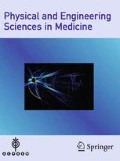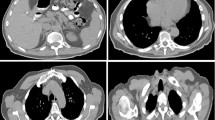Abstract
Volumetric medical imaging lacks a standardised coordinate geometry which links image frame-of-reference to specific anatomical regions. This results in an inability to locate anatomy in medical images without visual assessment and precludes a variety of image analysis tasks which could benefit from a standardised, machine-readable coordinate system. In this work, a proposed geometric system that scales based on patient size is described and applied to a variety of cases in computed tomography imaging. Subsequently, a convolutional neural network is trained to associate axial slice CT image appearance with the standardised coordinate value along the patient superior-inferior axis. The trained neural network showed an accuracy of ± 12 mm in the ability to predict per-slice reference location and was relatively stable across all annotated regions ranging from brain to thighs. A version of the trained model along with scripts to perform network training in other applications are made available. Finally, a selection of potential use applications are illustrated including organ localisation, image registration initialisation, and scan length determination for auditing diagnostic reference levels.




Similar content being viewed by others
Data availability
Patient data used for training is not available, however scripts to perform training tasks with Tensorflow along with a copy of the trained AI model have been made available at https://github.com/jacksonmedphysics/AI-CT_to_Reference_Geometry.
Code availability
See above.
References
Huang R, Xie W, Noble JA (2018) VP-Nets: efficient automatic localization of key brain structures in 3D fetal neurosonography. Med Image Anal 47:127–139
Liang X et al (2020) A deep learning framework for prostate localization in cone beam CT-guided radiotherapy. Med Phys 47(9):4233–4240
Onieva JO et al (2018) Multiorgan structures detection using deep convolutional neural networks. In: Medical imaging 2018: image processing. International Society for Optics and Photonics
de Vos BD et al (2017) ConvNet-based localization of anatomical structures in 3-D medical images. IEEE Trans Med Imaging 36(7):1470–1481
Xu X et al (2019) Multiple organ localization in CT image using triple-branch fully convolutional networks. IEEE Access 7:98083–98093
Humpire-Mamani GE et al (2018) Efficient organ localization using multi-label convolutional neural networks in thorax-abdomen CT scans. Phys Med Biol 63(8):085003
Noothout JM et al (2020) Deep learning-based regression and classification for automatic landmark localization in medical images. IEEE Trans Med Imaging. https://doi.org/10.1109/TMI.2020.3009002
Hiraman A, Viriri S, Gwetu M (2019) Efficient region of interest detection for liver segmentation using 3D CT scans. In: 2019 conference on information communications technology and society (ICTAS). IEEE
Chollet F (2017) Xception: Deep learning with depthwise separable convolutions. In: Proceedings of the IEEE conference on computer vision and pattern recognition
Deng J et al (2009) Imagenet: a large-scale hierarchical image database. In: 2009 IEEE conference on computer vision and pattern recognition. IEEE
Abadi M et al (2016) Tensorflow: a system for large-scale machine learning. In: 12th {USENIX} symposium on operating systems design and implementation ({OSDI} 16)
Jackson P et al (2018) Deep learning renal segmentation for fully automated radiation dose estimation in unsealed source therapy. Front Oncol 8:215
Abdollahi B, Tomita N, Hassanpour S (2020) Data augmentation in training deep learning models for medical image analysis. Deep learners and deep learner descriptors for medical applications. Springer, Cham, pp 167–180
Jackson P (2020) AI-CT to reference geometry. Available from https://github.com/jacksonmedphysics/AI-CT_to_Reference_Geometry
Çiçek Ö et al (2016) 3D U-Net: learning dense volumetric segmentation from sparse annotation. In: International conference on medical image computing and computer-assisted intervention. Springer
Acknowledgements
Price Jackson is supported by a fellowship from the Victorian Cancer Agency.
Funding
Price Jackson is supported by the Victorian Cancer Agency on a Nursing and Allied Health Fellowship (CRFNAH17008: Application of modern image processing and machine learning techniques for individualised management and optimised use of targeted therapy in neuroendocrine cancer).
Author information
Authors and Affiliations
Corresponding author
Ethics declarations
Conflict of interest
There are no conflicts of interest to report in this work.
Ethical approval
The retrospective use of patient data for method development (creation of image analysis tools) is considered as part of best-practice optimisation and does not require specific ethics approval or patient consent according to our human research ethics committee.
Informed consent
As above.
Additional information
Publisher's Note
Springer Nature remains neutral with regard to jurisdictional claims in published maps and institutional affiliations.
Rights and permissions
About this article
Cite this article
Jackson, P., Korte, J., McIntosh, L. et al. CT slice alignment to whole-body reference geometry by convolutional neural network. Phys Eng Sci Med 44, 1213–1219 (2021). https://doi.org/10.1007/s13246-021-01056-5
Received:
Accepted:
Published:
Issue Date:
DOI: https://doi.org/10.1007/s13246-021-01056-5




